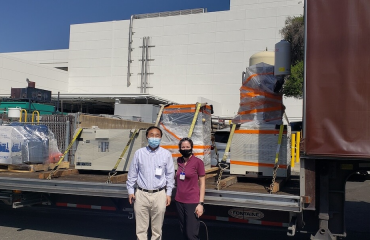Volta bets on space technology for battery storage fire prevention – Utility Dive
Although lithium-ion batteries are the dominant energy storage technology on the market because of their cost and availability of materials, they do carry safety risks. One of the biggest concerns is thermal runaway, where a cell in a lithium-ion battery pack overheats and causes a chain reaction of other overheated cells, resulting in a fire or explosion. While any number of factors can contribute to a cell overheating, experts say that preventing those failures from escalating is key for safety.
“For large battery packs, one fault or disturbance can propagate into a much larger effect,” said Ken Boyce, senior director of principal engineering of Energy and Industrial Automation for the safety science firm UL. “Energy storage is super important for us to get right and battery safety is a critical aspect of that. It’s good to see innovation broadly in terms of advancing the safe use of battery technology.”
The safety concerns were brought into sharp relief in 2019, when an explosion at Arizona Public Service’s McMicken battery plant injured four emergency responders and forced state regulators to reconsider safety rules for the growing storage industry. More recently, a fire broke out at Australia’s Victorian Big Battery storage project, built with Tesla Megapack units, and an overheating incident caused the 1.2 GWh Moss Landing storage facility in California to go off-line, although the failed cell was safely contained.
KULR’s PPR design has a variety of safety mechanisms, including a thermal runaway shield that absorbs the heat from a battery cell, preventing other cells from heating up. It also includes internal short circuit technology, or trigger cells, that can be used to simulate safety issues and better identify design flaws. KULR CEO Michael Mo said this was the first time the internal short circuit technology had been applied to energy storage.
The two partners have done more than 18 months of testing (destroying some $3.5 million worth of cells, Williams said) to adapt the technology from its mobile uses to stationary energy storage. The storage packs are larger and have different design requirements, Mo said, adding that some of the safety requirements specific to space missions were relaxed.
“We’ve been continuing to evolve and develop this technology and we are excited to see it deployed for storage,” Mo said. “With our design, there will not need to be a lot of expensive external parts and systems in the building to put out a thermal runaway event.”
The three-year partnership includes $1.6 million for immediate delivery of batteries. Williams said Volta plans to bring between 750 and 1,000 units to market in 2022, increasing to up to 50,000 units in 2023.
“Our objective is to get this technology deployed very very quickly … and bring energy in a permanent, portable form to every use in the economy.”
Davion Hill, co-founder of Momentum Energy Storage Partners and an expert on battery safety, said that while he had not specifically reviewed KULR’s technology, “in principle” it should be a positive application for storage. “If it demonstrates it can limit cascading failures … that solves a lot of problems,” Hill said.
Williams said he “can’t overstate the importance” of reliable and durable safety systems for energy storage, both for the industry’s growth and the overall transition to renewable power.
“For a pack system to be in someone’s home or a hospital or a daycare center or a university or gas station or even an accountant’s office, that pack has to be failsafe,” Williams said. “When everything fails, will it be safe? Getting there is critically important at a macro level to expand storage for renewables, but on a micro level for Volta, this is the most significant product we will have on the market.”
Follow Jason Plautz on Twitter
Get the free daily newsletter read by industry experts
Topics covered: smart grid tech, clean energy, regulation, generation, and much more.
FRAMECAD
The National Renewable Energy Laboratory's annual report finds that U.S. solar and storage prices have dropped significantly, but researchers warn that rising raw materials costs could slow the reductions.
Observers say it is possible the deal can be salvaged, but for now concerns over reliability and the development of renewable resources have scuttled the proposed $8 billion merger.
Subscribe to Utility Dive for top news, trends & analysis
Topics covered: smart grid tech, clean energy, regulation, generation, and much more.
Get the free daily newsletter read by industry experts
Topics covered: smart grid tech, clean energy, regulation, generation, and much more.
FRAMECAD
The National Renewable Energy Laboratory's annual report finds that U.S. solar and storage prices have dropped significantly, but researchers warn that rising raw materials costs could slow the reductions.
Observers say it is possible the deal can be salvaged, but for now concerns over reliability and the development of renewable resources have scuttled the proposed $8 billion merger.
The free newsletter covering the top industry headlines
Topics covered: smart grid tech, clean energy, regulation, generation, and much more.



